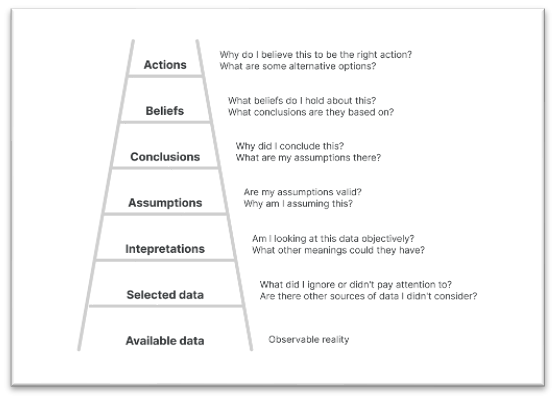Where’d you get your data!? Checking Your Assumptions to Make Better Decisions
The human brain is a funny thing. It's like a computer – it never really shuts down and is always doing something in the background. Sometimes our brains move faster than us by taking in information around us, coming to conclusions, and making decisions based on assumptions informed by our experiences, education, and more. With this in mind, I want to propose that we spend more time challenging our assumptions to ensure we’re making the best decisions.
The ladder of inference is my new favorite tool to help challenge my assumptions and reflect on my decision-making. As a person who loves to problem solve (re: impulsive), at times I end up in situations where I cannot clarify the why behind my decision– regardless of whether it was a “good” or “bad” decision. In leadership roles, not having this clarity can create problems and unnecessary conflict. If I don’t know what led me to make a good decision, I will fail to guide and lead others to also make good decisions. If I don’t know what led me to a bad decision, then I set myself up to make that same decision again. Sometimes others will disagree with my decision – to engage in healthy and productive conflict, I need to be clear about why I disagree so we can come up with a solution we all agree with. The ladder of inference is a tool that can help us to reflect, challenge our assumptions, and make the best decisions.
There are two important reflection points that the ladder of inference poses that could be beneficial to anyone in any role. The first is recognizing/acknowledging and/or validating our assumptions. Too often I express assumptions as if they are fact. The ladder of inference points out that we make assumptions based on our interpretation of the data around us; however, more often than not we don’t check these assumptions or validate them through the perspective of others. In practice, one way we can check our assumptions is by doing community engagement to understand the true needs of clients or to understand the impacts of our work.
As we check our assumptions, the other reflection point is understanding what data has led us to this assumption. The ladder of inference acknowledges that while there is a wide range of data available to us, we often select data that reflects our personal experiences, education, how we’re feeling in the moment, history, and personal bias. It's totally okay that this happens, however, when our decisions impact others, it is important to engage with all the data to ensure our assumptions lead to actions that create an intended impact. In practice, there are lots of places we can collect data to understand the best action or the next most elegant step.
Team feedback
Targeted community engagement (internal or external)
Collecting stories about how your work has impacted people or the community
Statistics and research
Trends and constraints in the environment of your work
History – What has been done before? What worked and what didn’t work?
Our workplace culture has been shifting for several years and we still don’t have everything figured out. Additionally, many organizations and teams are working to create a more diverse and inclusive workspace, which is also new, and there is no clear path on how to get there. The ladder of inference offers us the opportunity to create a workplace environment that is rich with productive feedback, innovation, and collaboration which can lead to a deeper impact. All we have to do is be willing to ask the questions that will give us the information so we can make the best decision.



